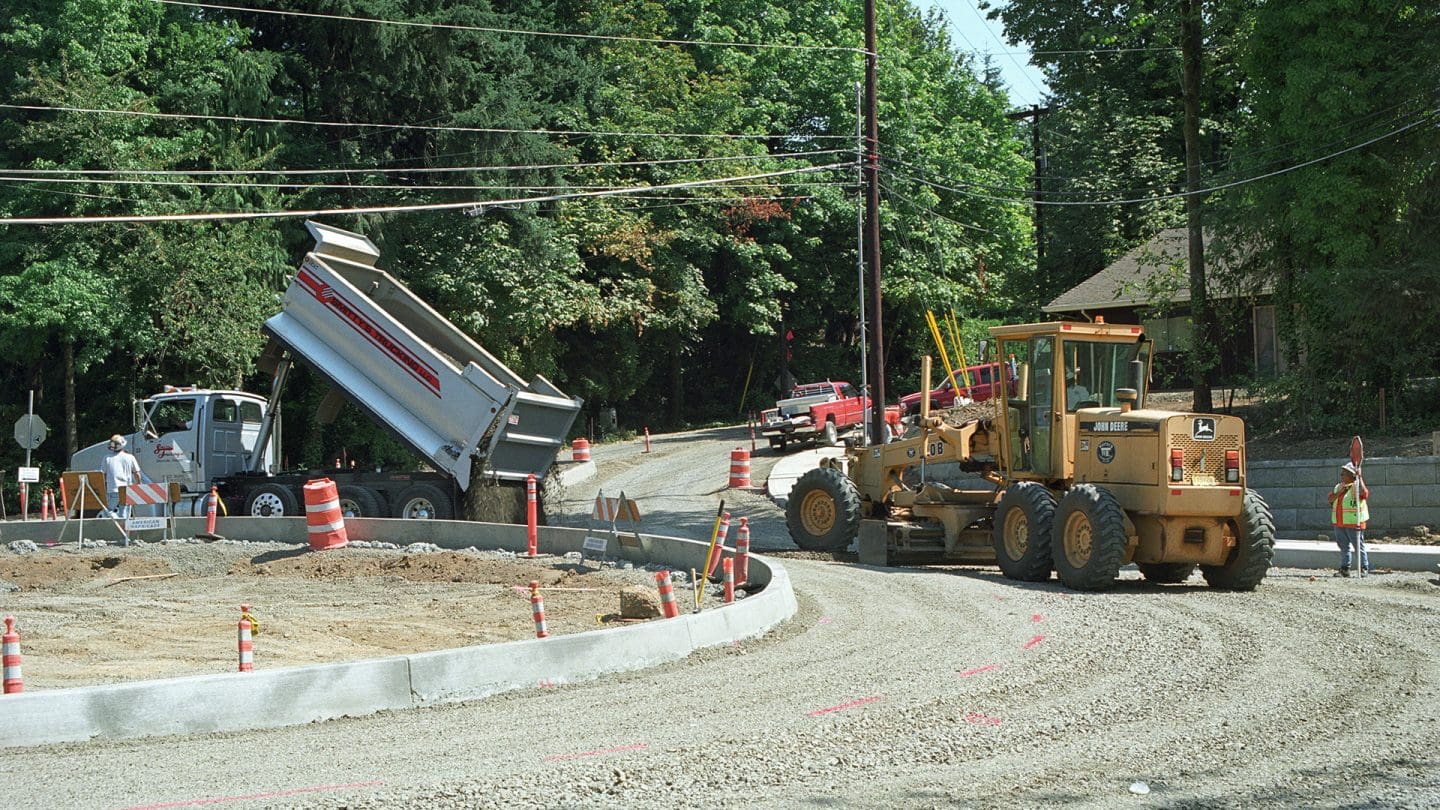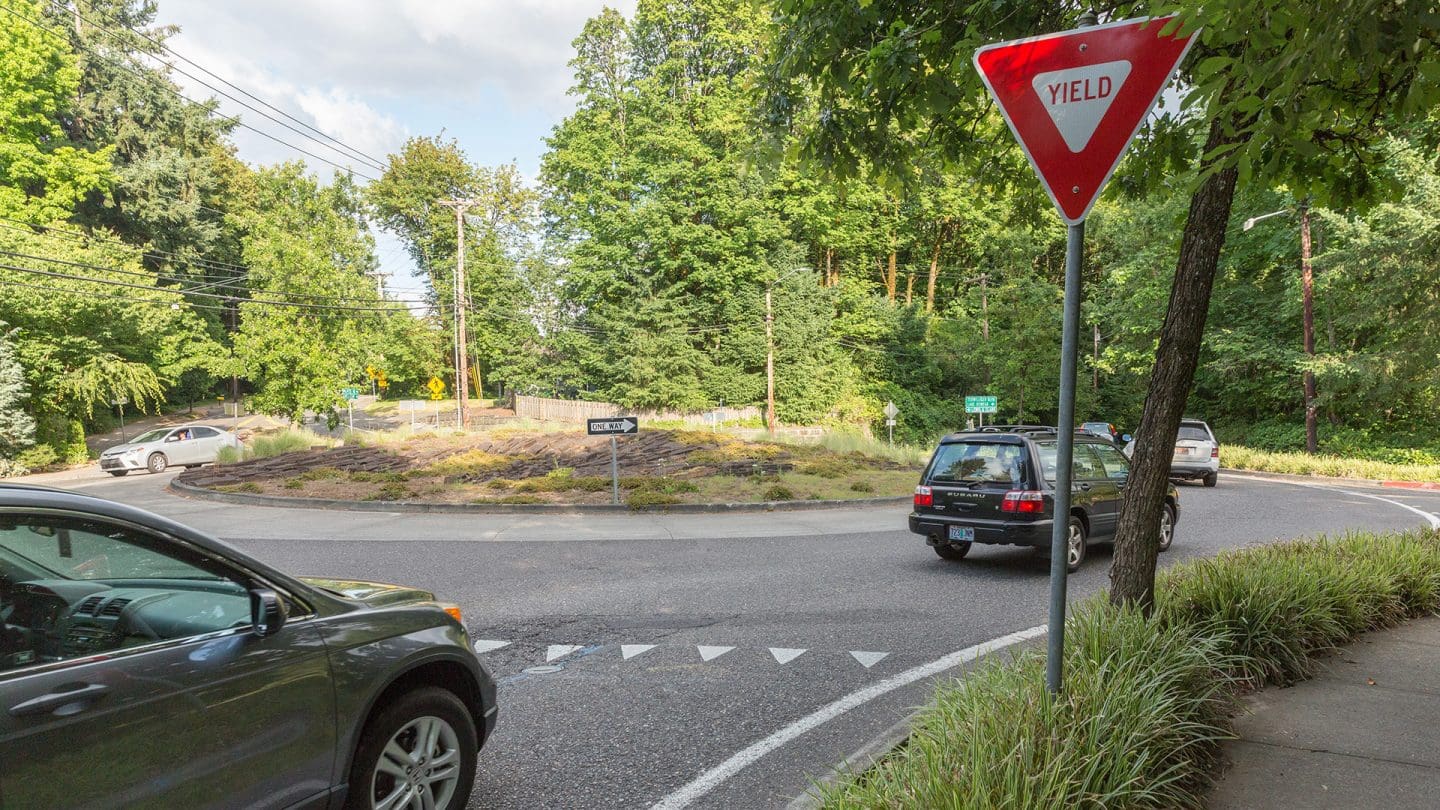September 15, 2019
It’s National Roundabouts Week! To celebrate, we’re highlighting a few of our favorite roundabout design projects over the years.
The Roundabout We Call “The Dogbone”
The 36th Street/Hill Road/Catalpa Drive intersection in Boise, Idaho existed as a skewed, five-leg signalized intersection. Half- to one-mile long lines of cars were common occurrences at the intersection, especially during school start and end times at Hillside Junior High School located at the intersection. The safety of school children, as well as of people walking and biking, was a major concern amongst those who regularly traveled through the intersection.
To address this “ruff” situation, that five-legged intersection got thrown a dogbone – a dogbone-shaped roundabout, that is! This design emerged as the best alternative, as it would minimize property and existing infrastructure impacts and cut the cost of the project by more than half. The dogbone roundabout was constructed in summer of 2016 and since then, it has reduced the long lines of cars down to typically only a few cars at a time.
The Roundabout That Makes You Pause
What do you do in a tight urban environment to reset the tone for drivers entering a residential area from a major arterial? The comma-shaped mini roundabout, or “comma-about,” at Southern Avenue and Whitfield Street in Boston, Massachusetts set out to do just that.
There had been a documented history of cars speeding through the intersection, and while some city engineers thought the issue could have been solved with a stop sign, Kittelson found a way to build a fully raised center island, which is better at promoting slow speeds.
The raised component of this mini roundabout can be landscaped to add an element of streetscape. Additionally, the comma shape fits within the right of way of the roadway and allows the same movements of the intersection as one of the streets is a one-way street.
Through the comma-about, the neighborhood streets are returned to the neighbors, with safety improved for people walking, biking, and driving through the intersection.
Eliminating 30-Minute Waits at Braddock Rd/Pleasant Valley Rd
In western Fairfax County, VA, drivers at the Braddock/Pleasant Valley intersection had experienced significant delays for several hours each day. There were numerous constraints to improving the intersection. Kittelson performed an extensive alternatives analysis of several traffic control and lane configuration options, and a 105-foot ICD roundabout was ultimately selected to minimize the footprint of the project, while solving the operational issues that plagued the intersection.
The project was successfully led and constructed through a design-build process by the Virginia Department of Transportation, opening to traffic in spring 2016. Since opening, the 30+ minute delays and mile-long queues have been eliminated, significantly improving travel times and the safety and operational performance of the intersection.
The Interchange Design Including Three Roundabouts
This interchange in La Center, Washington is built around a hat trick of roundabouts!
Plans to build a casino, resort, and tribal center would have led to increased traffic volumes on surrounding roadways and on the NW La Center Road/I-5 interchange in La Center. Working with the Cowlitz Tribe, the Washington Department of Transportation (WSDOT), and the City of La Center, Kittelson led a multidisciplinary team that planned, designed, and constructed a new interchange and modified the nearby roadway network. Using multi-agency workshops and unique public outreach activities, the team developed interchange concepts, traffic control plans, an access management approach, and local circulation alternatives, arriving at a complex but effective design involving three roundabouts.
The improvements have also resulted in lower maintenance costs, improved aesthetics, a gateway to the City of La Center and Cowlitz Reservation, and better safety for the traveling public. The La Center Interchange was named APWA Project of the Year in 2018 and the Oregon Daily Journal of Commerce Top Transportation Project of 2018.
Roundabouts Meet the Freight Industry in the Roundabout Rodeo
The City of Sisters, Oregon and ODOT were looking for ways to reduce crashes at the intersection of US 20 and Barclay Drive, considered to be the gateway to Sisters. A roundabout was selected as the preferred alternative; however, the freight industry had concerns about oversized vehicles navigating roundabouts, and one hadn’t been constructed on a state highway since 2002. ODOT, Parametrix and Kittelson decided to use the US 20/Barclay intersection project as a pilot project to help reach a consensus about roundabouts with the freight industry.
Our partnership with the freight industry included holding truck rodeo events using full-scale models built at the Deschutes County Fairgrounds and in Portland to test the roundabout and how it accommodated oversized vehicles. These rodeos helped us resolve policy issues and refine the design, including creating a unique bypass lane for the roundabout that can be used by oversized vehicles with special permits. The roundabout opened to traffic in June 2017, just in time for peak tourism season. Feedback from the community has been positive, particularly from local residents who had previously avoided crossing the highway at this location, and in 2018, the project won “Best in Category: Transportation from ACEC Oregon.
Bringing Safety to Deland, Florida Through a New Intersection Design
On behalf of the Florida Department of Transportation, Kittelson prepared a roundabout feasibility study at the SR 44/Grand Avenue intersection, which had been the site of multiple fatal crashes. Both a roundabout and traffic signal were evaluated, and the roundabout was recommended to be advanced into design. Kittelson prepared the horizontal roundabout design, which FDOT carried forward into an expedited design-build process.
The roundabout design supports the transition from a rural high-speed environment to an urban environment entering the City of Deland. The design of the roundabout also includes special consideration for accommodating oversize trucks carrying pre-stressed concrete beams from a nearby manufacturing facility. (Footage below courtesy of FDOT.)
The Roundabout That’s Been Designed 1,000 Times
Why has the roundabout at SW Terwilliger Boulevard and SW Palater Road in Portland been designed more than a thousand times? Because it’s frequently used as a teaching tool in our roundabout short course. It’s a good example of a roundabout’s ability to address capacity deficiencies while achieving the goals of the surrounding area – in this case, a college and a neighborhood – all within a location with challenging horizontal and vertical geometry. As Lee Rodegerdts, puts it, it’s “an oldie but goodie.”
Topographic constraints, access issues, and right-of-way impacts converged at the intersection of Terwilliger and Palater Roads. The intersection served as the gateway to a college, but it was also frequently used by residents, who wanted a traffic calming solution that wasn’t a traffic signal. After emerging as the preferred alternative, this roundabout continues to serve its community 18 years later. Fun fact: it was the first roundabout constructed in the City of Portland.

Terwiliger Palater Roundabout in Portland

Terwiliger Palater Roundabout in Portland
Left: Roundabout construction in 2001. Right: The completed roundabout in use.
The First of ~40 Modern Roundabouts in Bend, Oregon
Speaking of first roundabouts… we had the pleasure of working on the first modern roundabout in Bend, OR; this was also the first with which ODOT was involved. The roundabout can be found at the intersection of Colorado Avenue and Century Drive, which was previously controlled by two-way stop. Inspired by the success of roundabouts in Europe, private developer Brooks Resources initiated the idea and the roundabout was designed and developed through private/public partnership.
Fun fact: did you know there are no traffic signals on the west side of Bend? This first roundabout was part of a vision that led to the Bend City Council adopted a policy stating that roundabouts are the preferred option for intersection improvements. The City follows a practice of giving preference to roundabouts as a safe and efficient form of intersection control. Since this roundabout was constructed in 1999, ~40 have followed in the city and ~100 have followed statewide.
It’s fun to be able to say we’ve come up with roundabouts shaped like commas, dogbones, and peanuts, but the most important thing is these designs enhance safety and efficiency, and were developed in open collaboration with community members and key stakeholder groups.
To learn more about Kittelson’s design practice, check out our Work page, and don’t hesitate to contact us!
